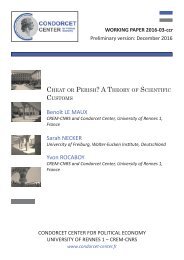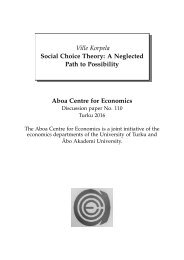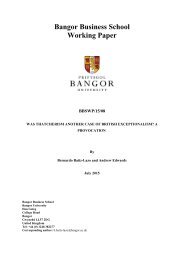MEMORANDUM
n?u=RePEc:hhs:osloec:2016_018&r=hpe
n?u=RePEc:hhs:osloec:2016_018&r=hpe
You also want an ePaper? Increase the reach of your titles
YUMPU automatically turns print PDFs into web optimized ePapers that Google loves.
passport issued just before he left Russia in 1925 carried the incorrect birth data. 17<br />
Whether the odd misstatement of the place and year of Leontief’s birth ultimately was just<br />
an odd and unfortunate accident or a falsification by the Church with connivance of the<br />
parents (or the other way around), we leave aside here. 18<br />
Since the return from Munich the family of three lived in one of four apartments in a<br />
house located in the San-Gali township, a settlement on Petrovskii island on the right bank<br />
of Neva. It was shared with two other sons of Wassily Iakovlevich: Aleksander and Leonid.<br />
A childhood memory for Wassily from this still peaceful time in St. Petersburg was that he<br />
and a cousin played with two bear cubs in the garden.<br />
Leontief Sr. brought his little son quite a few times to the house on the Zhdanovka<br />
River where Wassily’s step grandmother, Mariia I. Leont’eva, lived, not far from the San-<br />
Gali house. 19 Wassily retained at high age a vivid memory of the grand house designed by<br />
his grandfather who had not been an architect but liked to do everything by himself. The<br />
house was modeled on the style prevalent in St. Petersburg and located next to the factory<br />
at the confluence of Zhdanovka and Malaia Nevka rivers. Leontief remembered “a<br />
greenhouse with high palms in the house, and a huge ballroom where we used to dance”<br />
and small rooms like chapels with icons and icon-lamps where “lived a lot of aunts and<br />
dependents.” 20<br />
The Leontief family property also comprised an estate in Finland (under Russian<br />
suzerainty until 1918), serving as a dacha. It was located on the Karelian isthmus near the<br />
river Vuoksi and the Imatra falls, not very far from St. Petersburg. Birch forests and lakes<br />
with fishing opportunities made the estate attractive.<br />
A special memory connected with the Finnish estate came to Leontief’s mind when he<br />
was interviewed late in life about the political unrest in Russia in his youth: “I saw<br />
something on my own. We had a small estate in Finland, on the Karelian isthmus near the<br />
river Vuoksa. … when revolutionaries tried to leave Russia, they on occasion hid on our<br />
estate.” 21 This interesting but somewhat vague remark as to specific circumstances, again<br />
17 The same was the case for Leontief’s American passport issued after the naturalization in 1938,<br />
and his autobiographical information at the Nobel Prize award in 1973,<br />
https://www.nobelprize.org/nobel_prizes/economic-sciences/laureates/1973/leontief-bio.html<br />
18 The significance of the wrong birth year was that it implied the appearance that Leontief was<br />
born of an Orthodox, rather than Jewish, mother. The fact that the Leontief family adhered to the<br />
Old Believers may have played a role. It is uncertain when Leontief became fully aware of the facts<br />
but as both parents were enlightened and liberal persons he was hardly very old. The naturalization<br />
was one of several opportunities to resolve the issue but Leontief acted as if such details meant very<br />
little to him, cf. Bjerkholt and Kurz (2006, p.332).<br />
19 Kaliadina and Pavlova (2006, p.338).<br />
20 Kaliadina (2006, p.347)<br />
21 Kaliadina (2006, p.348).<br />
11





